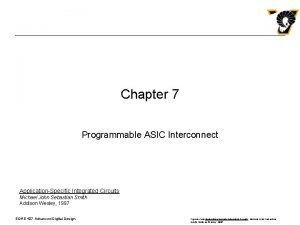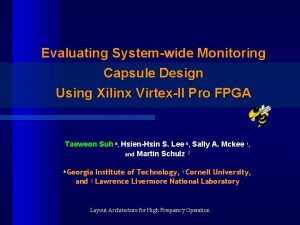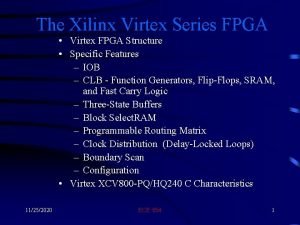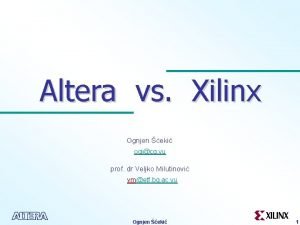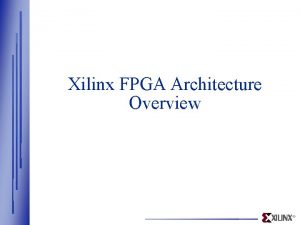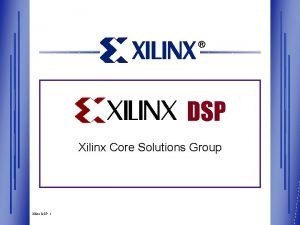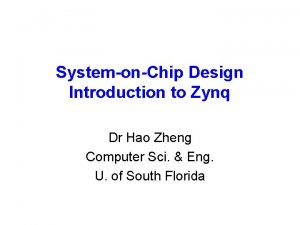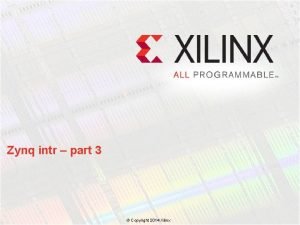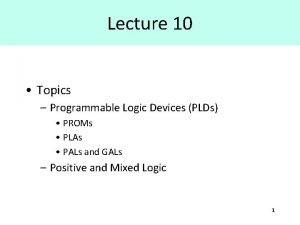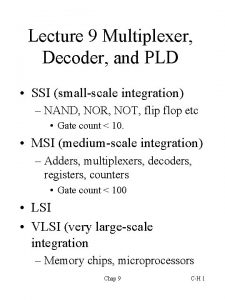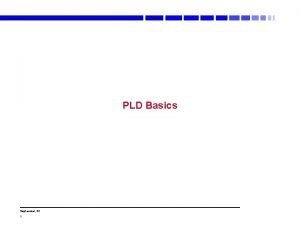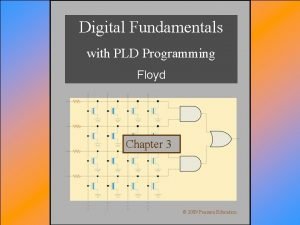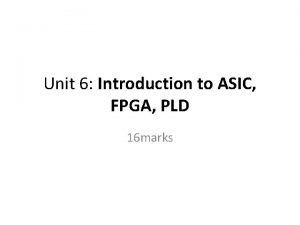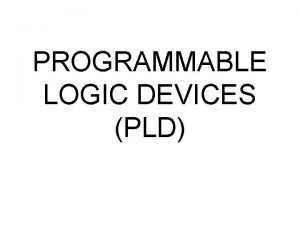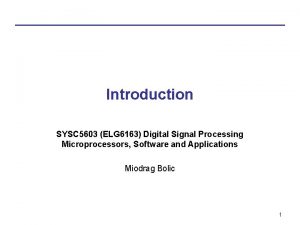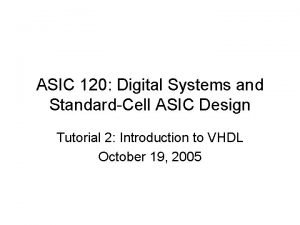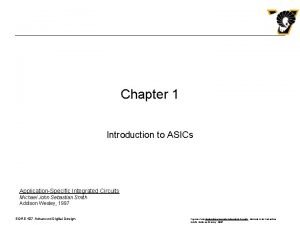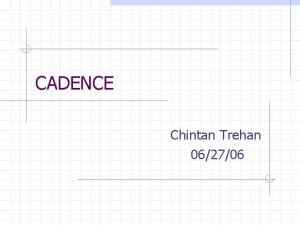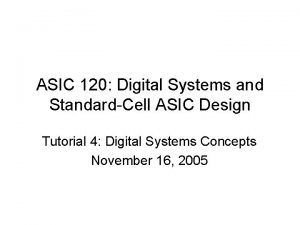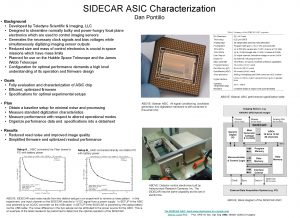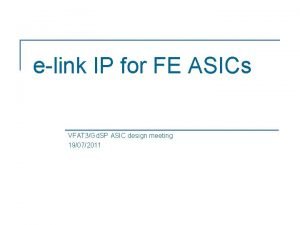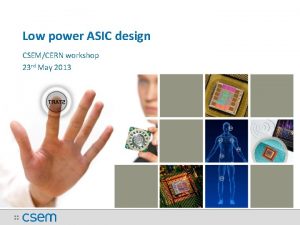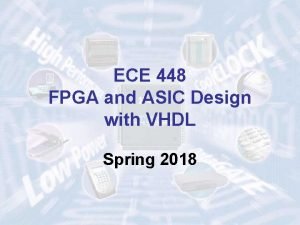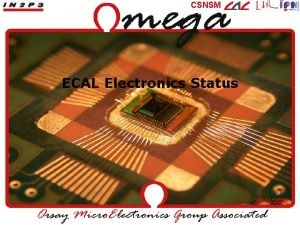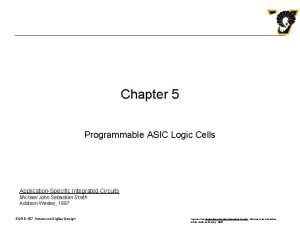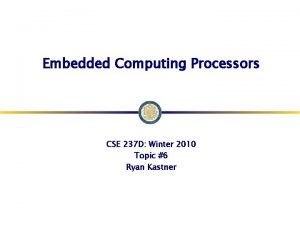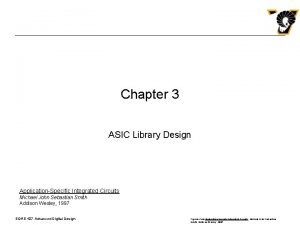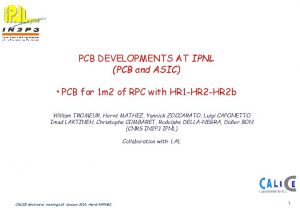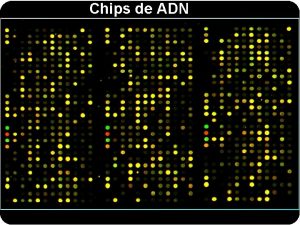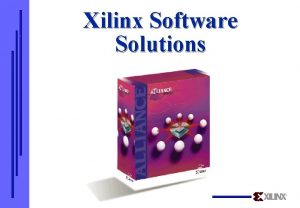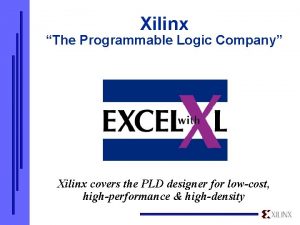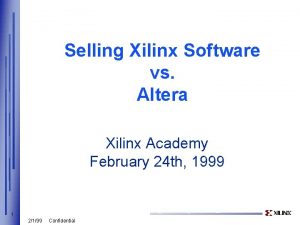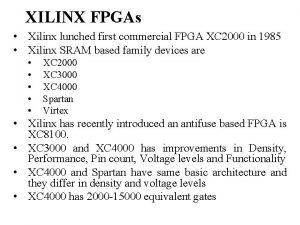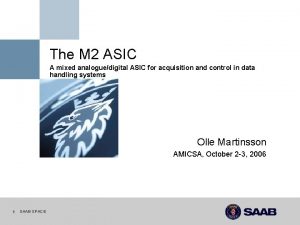Contents Implementation Technologies Standard chips PLD ASIC Xilinx





































































- Slides: 69


Contents • Implementation Technologies - Standard chips - PLD - ASIC • Xilinx device products - Cool. Runner - Spartan - Virtex • Altera device products - MAX II - Statrix II

Standard Chips VDD 7404 (a) Dual-inline package (DIP) VDD 7408 Gnd (b) Structure of 7404 chip x 1 x 2 x 3 7432 f

Programmable Logic Devices (PLD) • First introduced in 1970 s • PLD contains - Logic gates - Programmable switches • Types of PLDs - Simple PLD • Programmable logic array (PLA) • Programmable array logic (PAL) - Complex programmable logic devices (CPLD) - Field-programmable gate arrays (FPGA)

Recap - Programmable Logic Devices (PLD)

Generalized PAL

Programmable Logic Device (PLD) • Simple PLD (SPLD) & Complex PLD • SPLD - PAL itself is considered as SPLD - The fixed part (the blue part of the previous slide) is called “Macrocells” - A macrocell is with one OR gate and associated output logic. - A typical SPLD has 8~10 macrocells within one IC package.

PAL with Macrocells

Basic Macrocells Y=A’B+AB’ If B=1, Y=A’

SPLD designation • 16 V 8 and 22 V 10 are common. Number of inputs Type of output logic (Variable) Number of outputs

16 V 8 SPLD

Sequential PLD • Sequential Programmable Logic Device (SPLD)

Basic Macrocell of Sequential PLD

Complex PLD (CPLD) • CPLD consists multiple SPLD arrays and programmable interconnections. - LAB = SPLD - PIA: Programmable Interconnect Array • LAB & PIA are programmed using software. • CPLD “density” is usually specified in terms of macrocells or LAB. • Altera & Xilinx are the major manufacturers.

Altera CPLDs • Altera produces three lines of CPLDs - EPLD series - MAX series - FLEX series • It also produces a complete design tool - MAX+PLUS 2 - Quartus II

Entry Level EPLD Series • EPLD 220 device - standard AND/OR structure - replaces a PAL 16 L 8 or PAL 16 R 8 - can operate at near 100 MHz - pin to pin delays of about 7. 5 nsec Package

EPLD 220 Macrocell • The Macrocell for the EPLD 220 is a registered programmable level structure Select combinational or registered output up to 8 terms in a function

Altera MAX 7000 CPLD

Altera MAX 7000 Macrocell • • • A programmable AND array 5 AND gates A product-term selection matrix 1 OR gate Associated logic that is programmable to be - input - combinational logic output - registered output (sequential output)

Shared expander • Example of how a shared expander can be used in a macrocell to increase the number of product terms.

Using a shared expander term from another macrocell to increase an SOP expression

Parallel expander

Using parallel expander terms from another macrocell to increase an SOP expression.

MAX II CPLD • Logic array blocks with multiple logic elements • Uses Lookup table (LUT) instead of ANDOR array • Programmable interconnects • Input/Output elements (IOE)

Xilinx CPLDs • Cool. Runner II, XC 9500 • XC 9500 is similar to MAX 7000, has PAL architecture • Cool. Runner II has PLA architecture

Recap – PAL vs. PLA

Cool. Runner II Architecture • FB = LAB • AIM (Advanced Interconnect Matrix) = PIA • 2~32 FBs

Simplified FB structure

FPGA • Provides logic blocks instead of AND or NAND plane - Typical logic blocks is LUT • Volatile devices - Programmable read-only memory (PROM) can be used to make it nonvolatile

LUT as Logic Block 3 -input LUT x 1 x 2 0/1 0/1 x 3 Program is actually written in Memory, just like conventional CPU with Main Memory. f

General Structure of FPGA Pin grid array (PGA) package

FPGA Example f 1 f 2

FPGA concept • Field Programmable Gate Array • Basic elements: - Configurable logic block (CLB) - I/O block - interconnections • CLB is simpler than LAB or FB, but there are many more of them

Configurable Logic Block (CLB) • Many FPGAs are volatile because their LUTs are based on SRAM.

Altera FPGAs • High & Medium Density FPGAs - Stratix II, Stratix, APEX II, APEX 20 K, & FLEX 10 K • Low-Cost FPGAs - Cyclone & ACEX 1 K Stratix II FPGA LAB (logic array block) structure

Adaptive Logic Module • • Normal mode Extended LUT mode Arithmetic mode Shared arithmetic mode

ASIC • Application-specific integrated circuit - Smallest size - Fastest speed - Lowest power • Microprocessors or memory chips - Not standard • Types of ASIC - Custom chips - Standard cell chips - Gate array

Standard Cell Chips • Use the pre-designed layout of individual gates • CAD tools arranges all the gates

Gate Array • Gate array part is prefabricated. • Other parts are custom fabricated. - Wiring • Sea-of-gate

Which Way to Go? ASICs High performance FPGAs Off-the-shelf Low development cost Low power Short time to market Low cost in high volumes Reconfigurability

Other FPGA Advantages • Manufacturing cycle for ASIC is very costly, lengthy and engages lots of manpower - Mistakes not detected at design time, which have large impact on development time and cost - FPGAs are perfect for rapid prototyping of digital circuits • Easy upgrades like in case of software • Unique applications - reconfigurable computing

Major FPGA Vendors SRAM-based FPGAs • Xilinx, Inc. Share over 60% of the market • Altera Corp. • Atmel • Lattice Semiconductor Flash & antifuse FPGAs • Actel Corp. • Quick Logic Corp.

Contents • Implementation Technologies - Standard chips - PLD - ASIC • Xilinx device products - Cool. Runner - Spartan - Virtex • Altera device products - MAX II - Statrix II

Xilinx • Primary products: FPGAs and the associated CAD software Programmable Logic Devices ISE Alliance and Foundation Series Design Software • Main headquarters in San Jose, CA

Xilinx FPGA family

Xilinx Cool. Runner • • • MC: Macrocell AIM: Advanced Interconnect Matrix The Function Blocks use a Programmable Logic Array (PLA) configuration which allows all product terms (p-term) to be routed and shared among any of the macrocells of the FB.

Cool. Runner Macrocell

Cool. Runner Macrocell • SOP logic expressions up to 40 inputs and span 56 product terms within a single function block. • The macrocell can further combine the SOP expression into an XOR gate with another single p-term expression. • The logic function can be pure combinational or sequential • The storage element operating selectably as a D or T flip-flop, or transparent latch. • Each macrocell flip-flop is configurable for either single edge or Dual. EDGE clocking, providing either double data rate capability or the ability to distribute a slower clock (thereby saving power). For single edge clocking or latching, either clock polarity may be selected per macrocell.

Spartan 3 E • • • Digital Clock Manager (DCM) Blocks Configurable Logic Blocks (CLBs) contain flexible provide self-calibrating, fully digital solutions for distributing, delaying, Look-Up Tables (LUTs) that implement logic plus storage elements used as flip-flops or latches. multiplying, dividing, and phase. CLBs perform a wide variety of logical functions shifting clock signals. as well as store data. Input/Output Blocks (IOBs) control the flow of data between the I/O pins and the internal logic of the device. Each IOB supports bidirectional data flow plus 3 -state operation. Supports a variety of signal standards, including four highperformance differential standards. Double Data. Rate (DDR) registers are included. Block RAM provides data storage in the form of 18 -Kbit dual-port blocks. Multiplier Blocks accept two 18 -bit binary numbers as inputs and calculate the product.

Spartan 3 E - CLB

Spartan 3 E - CLB

Spartan 3 E - Slice • Common resources in both SLICEM & SLICEL - Two 4 -input LUT function generators, F and G Two storage elements (Flip-flops) Two wide-function multiplexers, F 5 MUX and Fi. MUX Carry and arithmetic logic • The SLICEM pair supports two additional functions: - Two 16 x 1 distributed RAM blocks, RAM 16 - Two 16 -bit shift registers, SRL 16

LUT (Look-Up Table) Functionality • Look-Up tables are primary elements for logic implementation • Each LUT can implement any function of 4 inputs

5 -Input Functions implemented using two LUTs LUT OUT LUT

FPGA Nomenclature

Device Part Marking XC 3 S 100 -4 FG 256

Xilinx Virtex • IO is enhanced - Embedded Rocket. IO™ (up to 3. 125 Gb/s) or Rocket. IO X (up to 6. 25 Gb/s) Multi-Gigabit Transceivers (MGTs). • Processor is added - Processor blocks with embedded IBM Power. PC™ 405 RISC CPU core (PPC 405) and integration circuitry.

Virtex – Processor block • Embedded IBM Power. PC 405 -D 5 RISC CPU core • On-Chip Memory (OCM) controllers and interfaces (between BRAM and Processor Core) • Clock/control interface logic • CPU-FPGA Interfaces (Block RAM)

Contents • Implementation Technologies - Standard chips - PLD - ASIC • Xilinx device products - Cool. Runner - Spartan - Virtex • Altera device products - MAX II - Statrix II

Altera • FPGA • CPLD • Structured ASIC - Only a part of “layers” are customizable

Altera – MAX II • FB LAB • MC LE

MAX II LE

MAX II - LE • A four-input LUT • A programmable register (flip-flop) - Programmable register can be configured for D, T, JK, or SR operation. - Each register has data, asynchronous load data, clock enable, clear, and asynchronous load/preset inputs. • Single bit addition or subtraction with carry chain

MAX II LAB

MAX II Family

Altera - Statrix II

Statrix II - ALM • A LAB has eight ALM • LE ALM (Adaptive logic module)

Statrix II family

Statrix II family
 Multiplication rule
Multiplication rule A box contains black chips and white chips
A box contains black chips and white chips Pannon egyetem műszaki informatikai kar
Pannon egyetem műszaki informatikai kar Programmable interconnect
Programmable interconnect Getting started with xilinx fpga
Getting started with xilinx fpga Vhdl when else
Vhdl when else Paul hartke
Paul hartke Vivado core generator
Vivado core generator Xilinx university program
Xilinx university program Fpga for dummies xilinx
Fpga for dummies xilinx Xilinx
Xilinx Xilinx 4000 series fpga
Xilinx 4000 series fpga Xilinx synthesis tool
Xilinx synthesis tool Total isp solution
Total isp solution Altera vs xilinx
Altera vs xilinx Xilinx fpga architecture
Xilinx fpga architecture Xilinx fpga editor
Xilinx fpga editor Dsp1
Dsp1 Rocketgtp
Rocketgtp Xilinx clock divider
Xilinx clock divider Xilinx soc
Xilinx soc Xilinx roadmap
Xilinx roadmap Xilinx concat
Xilinx concat Spartan 6 power estimator
Spartan 6 power estimator Vhdl
Vhdl Prom pld
Prom pld Pld pla
Pld pla Fixed function ic
Fixed function ic Cpld contains several pld blocks and
Cpld contains several pld blocks and Pld
Pld Pld programming
Pld programming Pld shift
Pld shift Pld fpga
Pld fpga Pld pla
Pld pla Complex adalah
Complex adalah Lg 6750
Lg 6750 The difference between fpga and pld is that
The difference between fpga and pld is that Sysc 2004 course outline
Sysc 2004 course outline Asic design flow tutorial
Asic design flow tutorial Application specific integrated circuits
Application specific integrated circuits Fowler
Fowler Horario ade upv
Horario ade upv Afslapplications
Afslapplications Asic regtech
Asic regtech 062706
062706 Asic design flow
Asic design flow Asic status
Asic status Standardcels
Standardcels Fpga to asic conversion
Fpga to asic conversion Sidecar asic
Sidecar asic Fpga vs asic
Fpga vs asic Structured asic
Structured asic Asic
Asic Asic
Asic High temperature asic
High temperature asic Semi custom asic
Semi custom asic Asic-e format
Asic-e format Low power asic design
Low power asic design Ece 448
Ece 448 Difference between asic and microcontroller
Difference between asic and microcontroller Electronics
Electronics Sandbox framework
Sandbox framework Asic accreditation
Asic accreditation The logic cells in fpga contains
The logic cells in fpga contains Cot asic
Cot asic Asic innovation hub
Asic innovation hub Asip vs asic
Asip vs asic Application specific integrated circuits smith pdf
Application specific integrated circuits smith pdf Asic pcb
Asic pcb Phrases of quantity food
Phrases of quantity food



